We're an affiliate
We hope you love the products we recommend! Just so you know, we may collect a share of sales or other compensation from the links on this page at no additional cost to you. Thank you if you use our links, we really appreciate it!
When your child is bitten by your furry sibling, the house instantly turns out to be chaotic. The baby may cry for a long while nursing the injuries sustained by your dog’s sharp teeth.
While it may appear that your dog overstepped his territory and disturbed your kid, oftentimes it is the other way round.
Many kids are usually rude to dogs because of their behaviors which pet parents often think are cute and harmless.
Your dog may keep up with the child’s behavior only for some time but in the long run, he may harm the kid by biting him off.

It is therefore important to know how kids should interact with dogs in order to prevent any harmful thing from happening to them.
Young children just like puppies require constant training to keep them at par with dogs in the house.
Teaching your kids how they interact with dogs is also a step in modeling their behavior in respecting pet animals.
In this post, we will give you a detailed guideline that you can follow to teach your dog proper interaction with dogs. This will enable the two sets of friends to create a good bond that will grow stronger together.
Introducing a Baby to a Dog
If you are getting a new dog, the first meeting between your child and the pooch can either be nervous or love at first sight.
Wherever you are going to pick your dog from, you can carry your child along so that he may see the new member coming to the family. This also gives the new dog an opportunity to see the little human in his future house.

When you have arrived in the house, you need to remind your child to let the new dog enjoy his space and bed without disturbance. Tell him that he should allow the dog to always initiate the first interaction.
How kids should not interact with dogs
Before teaching your child the things he should do to properly interact with dogs, you need to know the things that are to be avoided.
1. Do not disturb the dog while eating
It is common for children to poke their fingers into their parent’s plates while on the dining table. They unknowingly take this habit to the dog’s food bowl and disturb them while eating.

Your dog might keep up with this behavior for some time but ultimately, he will end up scaring away your child even by biting him off. Always inform your kids to give dogs their comfortable space while eating and discourage them from holding bones that belong to dogs.
2. Picking dog’s toys while he is playing
When your dog is playing with his interactive toys, your child may be tempted to come along and join in the game. In the process, he may end up picking some toys from the pup’s custody and running away with them.
This action will certainly offend your furry sibling and he might be triggered to scare away your kid by harming him.
Let your child learn the distinction between his toys and those that belong to the furry members of the family.
3. Grabbing the dog’s tail and ears
Your child will certainly appreciate how fluffy your pup’s body is and he will lay his hands over him to experience the coziness.
However, children tend to pull dogs by their tails and ears and it can be both painful and irritating to our furry friends.
You can solve this problem by teaching your child where and how to pat dogs gently to maintain a good friendship with the furry siblings.
4. Sleeping dogs should lie
When it comes to resting and sleeping, not even human beings like to be disturbed. However, it is different for kids because they always disturb their parents in their sleep in a bid to win their attention.
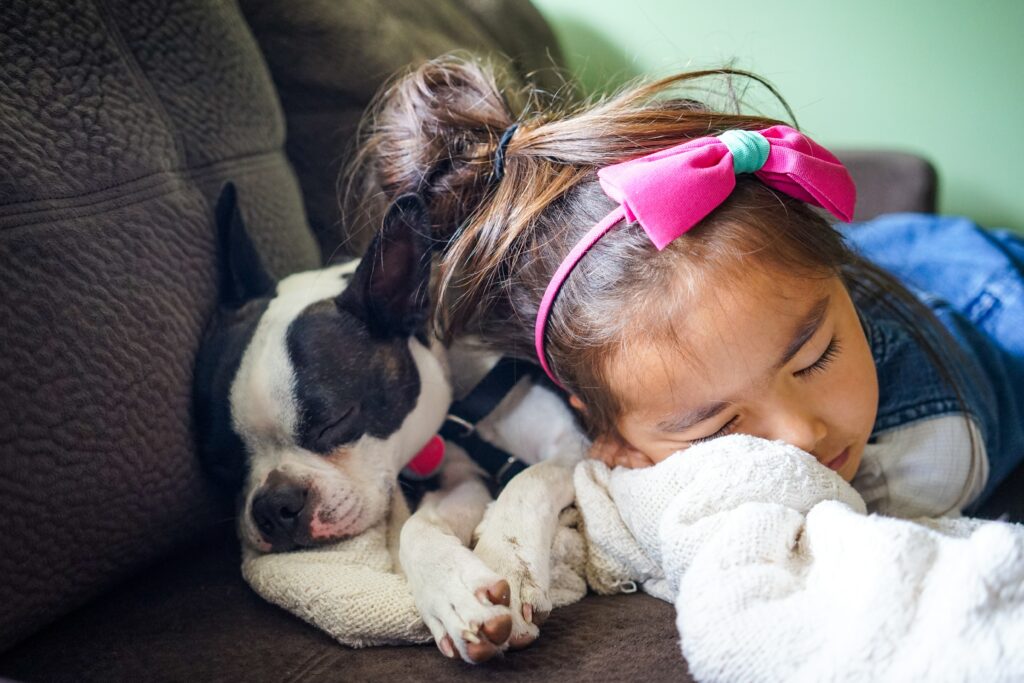
When dogs are disturbed during their sleep, they may not take it lightly. Your child puts himself in a dangerous position every time he encroaches on your dog’s sleeping area.
5. Avoid teasing your dog
Most children have the habit of poking and disturbing dogs to see how they react. To them, this might be a fun game because most dogs will just shy off and walk away.

However, there are some dogs who do not like to get teased. They may respond by harming your child in this case. It is important to tell your child not to tease your dog every time he sees him.
What To Do When Your Child Is Bitten by A Dog
It is always a good thing to see your child interacting and forming a strong friendship with your dog. However, as we have noted above, children may irritate calm dogs with their behavior leading to a short but painful scuffle.
In the unlikely event that your child gets bitten by an angry dog, you need to know a few things on how to go about saving the situation.
A good percentage of all dog bites on children happen to those who are 14 years and below. This number is continually increasing and it, therefore, calls for all pet parents to be in an informed position about dog bites.
Never leave your child with the dogs unattended to, but in the sad situation where a dog bite happens, you should do the following:
1. Take quick action
Immediately you notice a dog bite on your child, it is important that you take quick action before things get worse.
A dog’s mouth plays host to several bacteria which may leave your child with mild to severe infections. You need to wash thoroughly the place your child has been bitten with soap and clean water to eliminate bacteria that might have lingered on his skin.
2. Apply antibiotic medicine
After washing the wound clean, you need to apply antibiotic medication on the affected skin and wrap it up. This should be independent of whether your child is bleeding or not.
3. Visit the doctor
There are a few circumstances that may prompt you to visit your doctor immediately after your child is bitten by a dog.
If you are not sure about the health status of the dog, it is important to seek emergency medical attention because the dog might have the more dangerous rabies.
If the dog has caused a deep wound on your child’s neck or face, you need to see the doctor immediately to prevent further damage.
If you have tried maintaining your child’s wound but it can’t stop bleeding, then you need to seek further assistance from a medical officer.
Have a look at this video from McCann Dog Training that shows Dog Bite Prevention For Kids.
How Kids Should Interact with Dogs
With all the precautions with kids when interacting with dogs, it is possible to think that children cannot form strong bonds with their furry siblings.
Pet parents need to ensure that their kids are aware and taught of the dos and don’ts when it comes to handling canine pets.
Children should always be reminded not to treat dogs as toys but instead, they should embrace them as companions who have emotions and feelings. This will help them to learn when their fido is angry, happy, tired, sad, and so on.
Once you teach your child how to interact with his furry sibling, you can introduce games in which they can mutually play and strengthen their bond for the better.
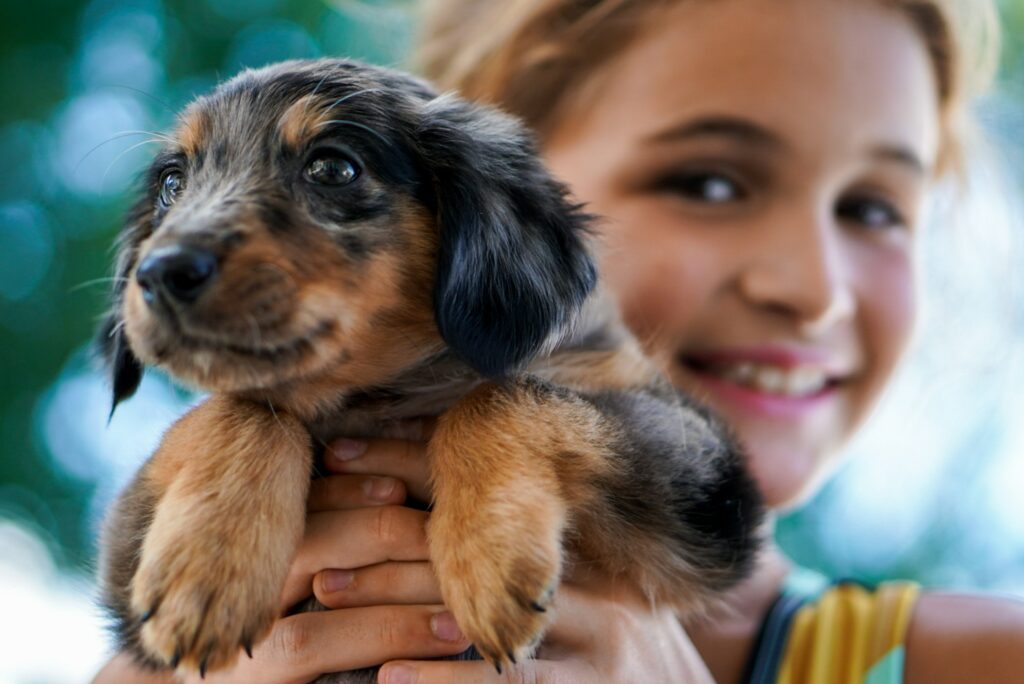
Both kids and dogs are motivated by games that stimulate their brains to make them more emotionally intelligent. They also appreciate little rewards given to them after completing a successful mission.
With this uniformity, it can be a very fascinating affair to have your kids develop a strong bond with the dogs in the right way.
For dogs to be healthy and fit, they need to undertake their daily exercises actively and children can be a great part of accomplishing this.
If you have a well-trained dog with good obedience training then you can teach your child how to participate in exercise sessions with him.

A good way of ensuring your kid develops a positive association with your dog is by allowing him to give the dog rewards in form of treats and toys. This will go a long way to ensure that your dog recognizes the child as part and parcel of the family.
As a pet parent, you need to ensure that ALL interactions between your kid and dog are supervised. This is irrespective of whether you have a calm well-trained dog and a well-taught child.
What to do
You can start the journey of building a strong relationship between your dog and kid by teaching him the following good behavior habits:
1. Being polite to dogs
Teach your kid to always be kind and polite to dogs. By doing this, your dog will recognize the good show of affection from your child and he can then interact with him peacefully.
2. Read dog’s emotions
Your kid should be in a position to know your dog’s emotions and how to handle them. If the furry sibling is anxious, encourage your dog to stay away from him until he cools down.
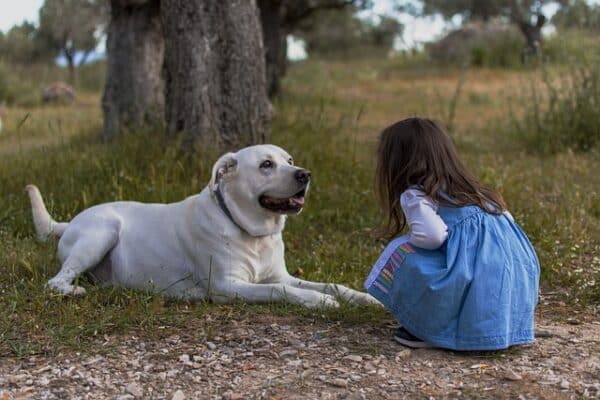
The best time for kids to interact with dogs is when the dog is wagging his tail and showing a calm and relaxed emotion towards him.
3. Play appropriate games
There are some easy and common games that you can introduce your child to play with your dog. These games include throwing and fetching balls, interacting with plush toys, and rewarding with treats.

You can then introduce the hide and seek game for your dog and child. Encourage him to reward the dog with a treat every time he finds him out of hiding.
With these games, your child will soon realize the fun side of your dog and he will start appreciating him as a worthy companion.
4. Petting
Dogs like to be petted in the right way and at the most appropriate places. Children will often find the dog’s fur hairy and comfortable to hold but they may end up hitting the dog in the wrong way in an attempt to pet him.
You should teach your child where and how to pet your furry friend every time he needs to get hold of him. This will help to strengthen the bond between the two.
5. Grooming
You can involve your child in daily brushing where he will clean the dog and straighten his fur. This is a great way to teach your child how to care for pets at a young age. It also provides a good avenue where the dog will appreciate services from the child.
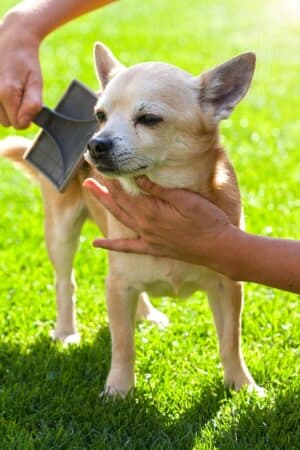
Supervising Your Child When Interacting with Dogs
Whenever your child wants to interact with dogs, you need to ensure that there is an adult offering supervision service. This is to ensure that no harmful activity will take place that may harm your child or dog.
The range and extent of supervision will depend on many factors including the child’s age, the dog breed, and the type of interaction in play.

If you have a new dog and you are still in the process of getting to know him, it is best not to put him close to your kids. This is because the dog is still very unpredictable and you may not know what may trigger and offend his emotions.
Close supervision when children are playing with dogs has been shown to prevent serious injuries that might have resulted from an agitated dog.
Conclusion
Learning how kids should interact with dogs is a precautionary measure that will prevent what could potentially be a harmful encounter between the two.
All pet parents should take an active approach in ensuring that their children grow up to form healthy relationships with their furry friends.
Remember to teach your kids never to interact with the neighbors’ dogs without permission.
Thank you for reading through this informational post. If you have any concerns or questions, please leave a comment below and I will get back to you.
Laura is the founder of Furs'n'Paws. She is a also a pet writer and expert with more than 20 years of experience of working with dogs and cats. She developed a very strong love for animals at a young age. Her passion led her to establish a thriving pet sitting and dog walking business in Dubai. As an expert in pet training, behavior, and nutrition, Laura is committed to helping pet owners and pet lovers by offering high-quality information on a wide range of topics.


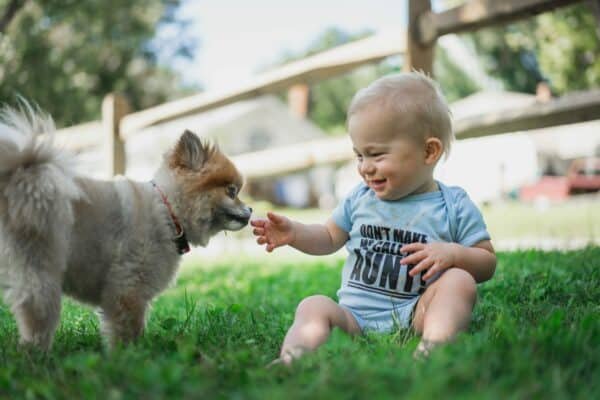
No responses yet